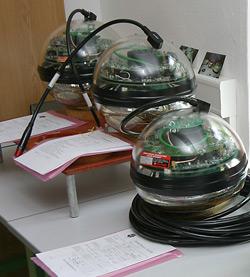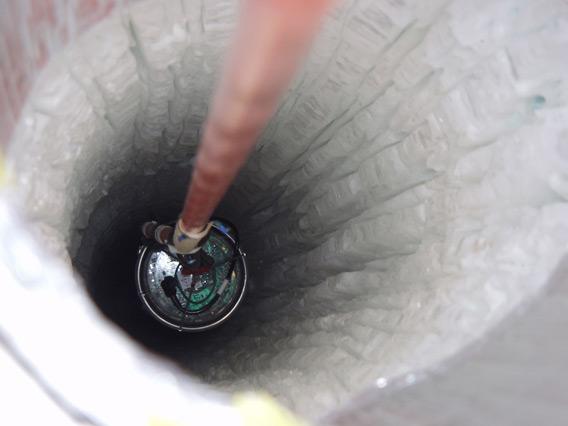I don’t get to write hyperbolic science fiction titles very often, but I couldn’t resist this one. Even if it’s not entirely accurate; in reality the experiment only most likely saw invading neutrinos from another galaxy. But it seems like they probably did. And they used faster-than-light travel to find them!
Well, kinda. OK, let me explain.
Neutrinos are subatomic particles, and they’re weird. They don’t interact with matter very much, so to them most of the Universe is transparent. They can pass right through the Earth without even noticing.
Really, though, to them the Universe is only mostly transparent. There’s a teeny tiny chance they’ll interact with matter. If you have enough neutrinos, a small number of them can ping off an atomic nucleus and create an effect we can measure. The good news is there are a lot of neutrinos flying around all the time. Billions of them are passing through you right now!
That makes them possible to detect if you are patient and careful. Happily, scientists are both. Neutrino detectors have been assembled in various parts of the world and have been pretty successful in finding the little suckers. They use various methods to see them; for example, some use the fact that when a neutrino slams into a chlorine nucleus, it can change it into an argon nucleus. Those detectors need huge amounts of chlorine for this, so they use tetrachloroethylene: dry cleaning fluid!
But the news today comes from a different kind of detector. This one relies on the idea that a neutrino passing through ice can create a shower of subatomic particles, like shrapnel. These particles scream out from the collision and can actually travel faster than light through the ice. I know, this sounds impossible, but light speed is the Universal limit when it’s traveling through a vacuum. Light slows down when passing through air, or liquid, or matter. So a subatomic particle can travel faster than light through matter, while still traveling slower than light does in a vacuum.
[Note: This is all very, very different than the claim of faster-than-light neutrinos from 2011. That turned out to be due to an equipment malfunction.]

Photo by: DESY
When this happens, the particle creates a shock wave, just like a sonic boom is created when something travels faster than sound. In this case, though, it’s not a sonic boom, but a photonic boom, a shock wave of light. This creates a faint blue flash called Cherenkov radiation, and that can be seen using very sensitive detectors.
Scientists have built just such a device in Antarctica. It’s called (get this) IceCube, and it consists of a string of detectors lowered 1,500 to 2,000 meters (1 to 1.5 miles) beneath the very clear ice. At that depth the ice is very smooth and dark, making it easier to see the flash of light from a neutrino reaction.
Neutrinos come from lots of different sources. Nuclear reactions in the Sun produce prodigious numbers of them, as do nuclear reactors on Earth, natural radiation from uranium decay inside the Earth, and even more exotic phenomena like exploding stars. These neutrinos all have different energies, so it’s possible in principle to categorize the source by looking at how energetic the detected neutrino is.
And that’s where IceCube has come through. Out of the countless detections it’s seen, two of them—nicknamed, seriously, Bert and Ernie—were phenomenally, unbelievably energetic: Each had an energy over one thousand trillion times the energy of a visible light photon. That’s huge, far larger energies than even the Large Hadron Collider can create. It’s very roughly equivalent to the energy of a raindrop hitting you on the head… which may not sound like much, but remember we’re taking about a single subatomic particle with that much energy. That’s phenomenal!

Photo by IceCube Collaboration/NSF
Not very many things in the Universe can make neutrinos with that much energy. Supermassive black holes in the centers of galaxies are one possible candidate; they are sloppy eaters, gobbling down and spewing out fantastically high-energy beams of matter and energy. Another possible source are gamma-ray bursts; explosions of stars so violent they are second only to the Big Bang itself. These typically occur in the very distant Universe, so statistically speaking if these are the engines making these super-high-energy neutrinos, then those little particles have traveled a long, long way before hitting the ice in Antarctica.
The scientists who made this detection note that they can’t completely rule out less exotic sources; there’s a 99 percent or so certainty that these neutrinos are not from some background source. That’s not quite enough to pass the rigorous standards of particle physicists (they prefer a minimum of 99.7 percent certainty to make a claim, and really a 99.9999 percent certainty to claim discovery, like with the Higgs particle last year).
Still, it’s provocative. And what a claim! Using faster than light particles to detect ghostly but super-high-energy intergalactic particles that have traveled tens or hundreds of millions of light years, only to get trapped beneath the Antarctic ice…
Hey, wait a second. I’ve seen that movie. I hope those scientists have flame throwers.
